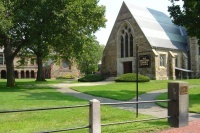c. 2008 Religion News Service
(UNDATED) In the cloistered world of Episcopal seminaries, time sometimes seems to stand still as clergy-in-training gather in stone chapels to pray in ways familiar to their forebears centuries earlier.
But the semblance of timelessness can be deceiving.
Some of the 11 seminaries affiliated with the Episcopal Church are slashing core programs, while others report rapid growth in enrollment. Still others are re-examining conventional wisdom about what it takes _ and how much it costs _ to shape a faithful priest.
The Episcopal method of training clergy “is a very expensive way to do theological education,” says Daniel Aleshire, executive director of the Pittsburgh-based Association of Theological Schools. “There is significant financial stress in the Episcopal seminary system.”
Centrist and liberal seminaries are facing especially hard times:
_ Last month, officials at cash-strapped Seabury-Western Theological Seminary in Evanston, Ill., announced plans to eliminate the residential Master of Divinity program and to discontinue faculty contracts in 2009.
_ Earlier this year, administrators at Bexley Hall Seminary in Columbus, Ohio, said they’d soon be shuttering their satellite campus in Rochester, N.Y., amidst accreditation concerns.
_ In Cambridge, Mass., Episcopal Divinity School is selling seven buildings to nearby Lesley University for $33.5 million as a part of a partnership agreement to stabilize the seminary’s finances.
Overall, enrollment in the Episcopal seminary system is down 25 percent from three years ago.
Not all schools are struggling, however. Theologically conservative seminaries report increases in enrollment since the 2003 consecration of openly gay Bishop V. Gene Robinson in New Hampshire.
Over the past five years, Nashotah House Theological Seminary in Nashotah, Wis., has added new degree programs and more than doubled its enrollment to 108. Trinity Episcopal School of Ministry in Ambridge, Penn., has seen its residential Master of Divinity program grow by more than 30 percent since the late 1990s, to about 40 students per class today.
Observers say the sexuality issue has played a role in seminary fortunes as certain bishops, once comfortable to send postulants to their nearest Episcopal seminary, now seek out more conservative training environments.
The trend toward conservative settings “has cost us some students every year,” says Gary Hall, president of Seabury-Western, where some faculty and students are openly gay. “It has been a factor, but I don’t think it’s the big trend.”
Money, in fact, may be the biggest issue. As a result, seminaries of all stripes are weighing whether they can afford to keep training clergy in a three-year, residential model that dates to the mid-1800s.
John Mitman, executive director of the Society for the Increase of the Ministry (SIM), a Connecticut-based nonprofit that provides financing for Episcopal seminarians, says students often balk at the prospect of relocating to such pricey cities as New York, Berkeley, Calif., and Cambridge, Mass., where tuition, books and living expenses can run upwards of $40,000 per year.
What’s more, those who leave seminary with debt face average annual student loan payments of more than $12,000 _ with an average starting salary of just $45,500.
“We hear this all the time,” Mitman says. “People are concluding, `I can’t make it work. I can’t borrow the money to do the seminary piece and go to work for the church for what the church pays and manage the debt.”’
(BEGIN FIRST OPTIONAL TRIM)
Not everyone, however, is convinced that costs are primarily driving trends in student enrollment.
Compared with other Episcopal seminaries, “our tuition is less and our cost of living is less, and I market those qualities,” says Trinity’s Dean of Students Tina Lockett. “But by and large, people are picking their seminary based on the quality of the academics, the theology of the faculty and the theological position of the seminary. They’ll work out the money as a secondary issue.”
(END FIRST OPTIONAL TRIM)
One result has been students opting to earn degrees through non-Episcopal seminaries close to where they live; fewer than half of newly ordained Episcopal clergy come out of Episcopal seminaries. That’s down from about 80 percent a decade ago, according to SIM data.
Others are moving away from a campus-based education. Trinity, for instance, allows Master of Divinity candidates to complete as much as two-thirds of their coursework online, and Episcopal Divinity School allows distance learners to earn a degree over five years as long as they spend four weeks per year on campus.
Some worry too much cost-cutting could take a toll on the spiritual formation for clergy. Mitman warns it’s inadequate “to do your spiritual formation by e-mail.”
The seminary experience “is taking a secular person and making that person into a spiritual being,” says Brett Donham, chair of the EDS board of trustees. “It’s learning a new language, a new way of seeing the world. (Seminarians) need to talk with each other and with people who’ve gone through it before.”
(SECOND OPTIONAL TRIM FOLLOWS)
Seabury-Western plans to revamp its Master of Divinity program with traveling courses, online studies and classes for commuters. Hall, the president, believes congregations are up to the task of molding future leaders through prayer, service and wise counsel.
“The seminary is a recent invention,” Hall says, noting it dates only to the 19th century. “It’s not like we’ve been doing it this way since Jesus. They way we’ve done it recently may be the optimal way, but we’ve got to find other ways to do it.”
KRE DS END MacDONALD975 words, with optional trims to 800
Photos from Episcopal Divinity School are available via https://religionnews.com.





